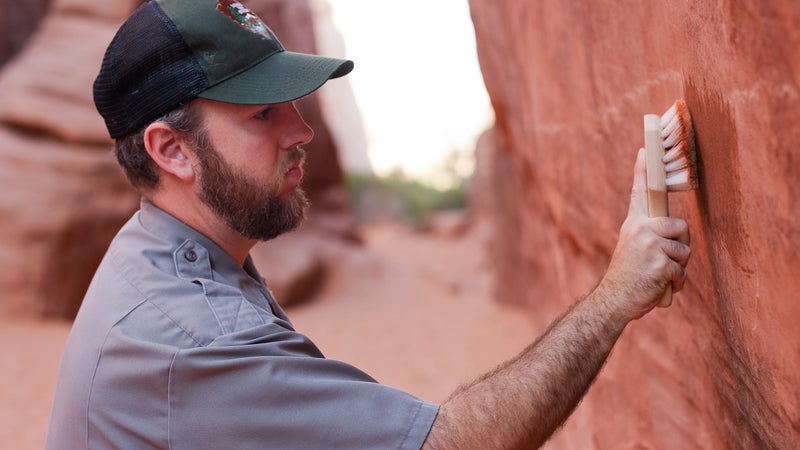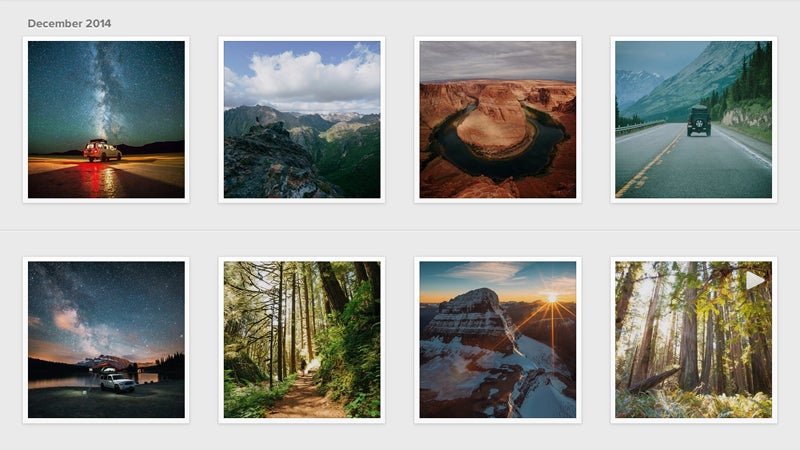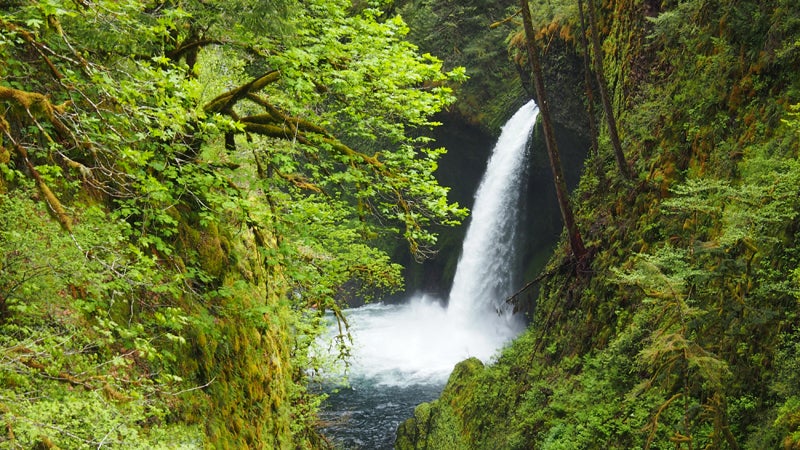Why Your Instagram Nature Shot Is Breaking the Law
In a new effort to protect national parks and wilderness areas from commercial photography, the feds have started going after amateur filmmakers with big social media followings.
New perk: Easily find new routes and hidden gems, upcoming running events, and more near you. Your weekly Local Running Newsletter has everything you need to lace up! .
Last fall, an Instagrammer named Casey Nocket made news when she posted photos of permanent acrylic portraits that she’d painted on rock faces in national parks across the country. Predictably, people were pretty upset both by her deeds and the callousness she appeared to have about her vandalism, writing in a comment under one of her photos, “I know, I’m a bad person.”
Nocket, who’s now under investigation by the National Park Service, represents an extreme example of a problem that’s been cropping up a lot lately: people getting in trouble with their cameras on public lands. Last September, there was the fuss over hikers at Lake Tahoe’s Taylor Creek taking selfies with black bears preying on spawning trout. The bears are so focused on the food that they often let hikers get within a few feet of them, which habituates the bears to humans and makes attacks more likely. That same month, in New Jersey, a Rutgers student was mauled to death by a black bear shortly after photographing it at close range.

It’s hard to draw a precise circle around any one type of behavior, but too many camera-wielding people have been getting crossed up with the law for it to be just a coincidence that the Forest Service chose last September to issue stricter guidelines for commercial photo permits. Generally, the incidents fall into one of two categories.
The first group, like Nocket, includes people who get into trouble because their pictures document them doing illegal stuff on public land. Nocket was willfully malicious, but when a Yosemite concession employee and popular Instagrammer named Trevor Lee pled guilty last fall in federal court, it was because he climbed trees and made campfires—in places where those activities were banned—all in hopes of taking a good picture. (Several of these photos were part of an online photo gallery that �����ԹϺ��� ran on its website over the summer.)
The second reason photographers, and especially videographers, find themselves on the wrong end of a subpoena is for shooting commercially on public land without filing for a filming permit. This second group of prosecutions occurs less frequently. I couldn’t find hard numbers for film-permit-related prosecutions, but anecdotally, what seems to be happening is that the Forest Service and Park Service prosecute for permit violations more often when they’re unhappy about something else—like vandalism or resource degradation.
What makes all of this interesting right now is that we’ve entered an era where a lot of photography is arguably commercial. Photos we used to print and store in albums are now getting posted to websites like Facebook, Instagram, and Flickr, which run all manner of ads against them. Vacation movies get posted to YouTube, again with advertisements. Posts by athletes, journalists, marketers, brands, and expectant parents all swim in the same pool. Even casual photographers can suddenly find themselves with large, dedicated followings that attract photo assignments and product placement within images. It’s getting really hard to tell what’s commercial, what’s personal, and what’s editorial.
I bounced this idea—that all content is increasingly commercial—off adventure photographer and filmmaker Jimmy Chin, who shot a World Series ad in Yosemite starring climber Alex Honnold for Web design template company Squarespace. “It’s easy to define projects when they are clearly commercial, such as the Squarespace shoot, but there is a ton of gray area, especially with social media becoming commercial and paid advertising,” says Chin. “It’s hard to define the boundaries of social because they’re constantly shifting. My Instagram account covers personal, commercial, and editorial work.”

, photographers with significant followings can get free plane tickets, hotel rooms, and other swag for posting photos. Andy Best, a popular Instagrammer and �����ԹϺ��� contributor, was approached by Toyota last year about helping the company promote its trucks. Others parlay Instagram into more traditional photo careers; still others use it to bolster their roles as professional athletes who act as marketers with gear companies or to help that their work comes with a built-in audience.
Mostly, there’s no harm in having more people in the woods with their cameras. Yosemite photographer Glen Denny was taking the Instagram five-day black-and-white photo challenge decades before it was cool. Even Ed Abbey while misbehaving in the wild. But as soon as you start talking about federally protected public land, there’s this very specific problem that arises. Most federal land-use policy curtails commercial use, and in federal wilderness areas, with certain exceptions for services like guiding and horse packing: “[T]here shall be no commercial enterprise and no permanent road within any wilderness area designated by this Act.” As with privacy, it’s a case where the Internet and its culture have raced ahead of the law.
These policies are meant to keep a leash on big productions that can quickly trample sensitive areas. Writers like �����ԹϺ��� contributor, guide, and adventure tourism industry pioneer Jack Turner have also argued that photographs can strip a place of its wild aura. The old question of whether a landscape photographer could and then sell his photo to a magazine was always just academic. The Park Service had little reason to waste time on something that wasn’t having an impact. Even Patagonia has never had problems , which despite being next to a road is in a wilderness area within Yosemite National Park.
Getting a permit isn’t really that hard—but it can be expensive. , it typically takes less than 30 days and costs $200 to $300 to apply and between $50 and $1,000 per shoot day, depending on how many people are involved and whether the production is big enough to require a Park Service monitor. That’s not much for a two-day TV commercial, but it’s outrageous if you’re just trying to chronicle your climbing buddies scaling a big wall for an adventure film. “The only thing to be concerned about when it comes to commercial filming is if somebody’s bringing props, sets, and models,” says Jeffrey Olson, a spokesperson for the National Park Service in Washington, DC.
In a , the Interior Department defines models as “a person or object that serves as the subject for commercial filming or still photography for the purpose of promoting the sale or use of a product or service.” Given that, it’s not hard to argue that we’re all models in the service of the various social media platforms. Or that sponsored athletes are models producing work of themselves in the service of the companies that sign their checks. (If that logic sounds even a little bit twisty, consider that the Park Service uses a to prosecute BASE jumpers for delivering themselves.) But Olson told me he couldn’t remember a case where the Park Service retroactively prosecuted somebody for filming something the agency later deemed to be a commercial work.
In fact, one such prosecution wrapped up this month. In 2012, Colorado Springs–based filmmaker Chris Alstrin released Wide Boyz, an indie adventure movie about two offwidth crack climbers from the United Kingdom that racked up a bunch of awards on the film festival circuit. A judging panel I sat on at Mountainfilm in Telluride named it the best climbing film of 2012. Late last year, the Park Service leveled charges against Alstrin in federal court, claiming he’d been filming commercially in Canyonlands National Park without a permit. The movie’s climax involved a heinous 5.14b offwidth roof called Century Crack. (Offwidth cracks are the hardest kind of climbing—too wide for classic hand-jamming techniques and too narrow to wedge your body inside.) “My lawyer told me that we could fight it and probably win,” says Alstrin, “but that it would cost more than just paying the fine.” In the end, the Park Service agreed that Alstrin would serve six months of probation and pay a $500 fine but would not have to admit guilt.
So why did the Park Service get serious in this case? After all, many amateur Banff and Mountainfilm directors either can’t afford the permitting process or don’t know they might need a permit. Alstrin thinks he was taking the fall for something the climbers themselves did that never actually appeared in the movie. “They picked up a rock off the ground, scratched ‘Century Crack’ on it and wrote the grade, and put it back on the ground at the base of the climb,” he says. The climbers then , though it’s since been taken down. “I think that’s what got the Park Service to start the investigation.”
In a written statement, NPS confirmed their worry about the incident, writing in part, “This destructive practice has long been out of favor with the climbing community, and is vandalism.”
Last September, the Forest Service, which is part of the U.S. Department of Agriculture, made headlines with its newly released rules on commercial filming. It announced plans to codify stringent permitting in the wilderness areas that it administers, going so far as to require news photographers to apply for permits. While the Forest Service quickly softened its language in the face of widespread public criticism of what was almost certainly a violation of the First Amendment, the move may signal more aggressive policing of photography and filming on public lands.
According to George Nickas, executive director of the hardline preservation group Wilderness Watch, the Forest Service was responding to , passed in 2000, which directed agencies to start issuing permits on lands administered by the Interior Department. Nickas believes that, far from being a tightening of restrictions on film permits, the Forest Service’s proposed September rule change would have enshrined a reversal of the Wilderness Act’s blanket ban on commercial activity. While reporters focused on the rule’s obvious First Amendment problems, most of us failed to notice that the rule would explicitly treat commercial film projects as a service, like guiding, and allow them into wilderness areas.
The Forest Service maintains that commercial filming was always a possibility in the wilderness as long as “those enterprises meet certain conditions, primarily to have a ‘wilderness purpose’ and have no negative effect on ‘wilderness character,’” according to Larry Chambers, the Forest Service’s national press officer. The proposed language has, in fact, already been in place as an interim policy for the past four years; the Forest Service will finalize its rule in the coming months.
In either case, it seems odd that the Forest Service would wait more than a decade to address the order from Congress. That may be because there wasn’t any pressing reason to act. But the past few years have seen an increase in people misbehaving in front of or behind the camera, beginning with Dean Potter’s 2006 climb of Delicate Arch, in Arches National Park, which led to a temporary park-wide ban on climbing all named arches. Last year in Arches, BASE jumper and slackliner “Sketchy” Andy Lewis, who appeared in Madonna’s 2012 Super Bowl halftime show, underwent an with park authorities after a BASE jump he made there last May. Lewis was banned from all national parks and riffed on Edward Abbey’s essay “Polemic: Industrial Tourism and the National Parks” in one of his many subsequent—often obscene—Facebook rants against the Park Service and individual rangers: “You know how much money we waste on national parks? $175,000 a day… All for the government to pave over and transform our most beautiful and magnificent lands into profitable tourist traps that attract literally millions of people per year.”

Two recent legal cases illustrate how serious the Forest Service has gotten about policing commercial photography. In June 2012, South African kayaker Steve Fisher, arguably the most prominent athlete in his sport, and Jackass TV personality Bam Margera plummeted over Oregon’s 100-foot Metlako Falls in a tandem kayak. Footage of the stunt was . That area of Eagle Creek is part of the Columbia River Gorge National Scenic Area (CRGNSA). Eight months later, the U.S. Forest Service prosecuted Fisher for “use of national forest land without special use authorization.” With his immigration status in jeopardy and thousands of dollars in legal fees hanging over him, Fisher pled no contest, agreed to pay a $185 fine, about his case, and serve a two-year ban from the area. In his note about the case, which he posted to his blog, Fisher warned other kayakers that “while it is legal to run the falls, you probably shouldn’t film or photograph it, since posting the images of a model/person to Facebook and YouTube constitutes publishing, which constitutes commercial photography.”
When I first read this on Fisher’s blog shortly after it happened, I was doubtful that the Forest Service would prosecute a sponsored athlete for making a video and posting it to YouTube. That’s a legal bar that would put most adventure athletes on the wrong side of the law. But that appears to be exactly what happened, and not only that, the video itself was the only evidence required to prosecute the case.
“It wasn’t so much a resource [degradation] concern so much as it being a commercial event,” says the Forest Service’s Stan Hinatsu. “As you know with the social media stuff going on, there’s some gray [area], but I just go back to the idea that we felt like it was a commercial activity, commercial in nature.”
The second criminal case involved a Discovery Channel personality named Brian “Pigman” Quaca, from the hunting show Boss Hog. In May 2013, Quaca pled guilty to filming in the Nantahala National Forest without a proper permit. He was fined $1,500. In that case, it wasn’t Quaca’s filming that drew an investigation. The feds were running a sting on the bear-hunting outfitter Quaca had employed, but they prosecuted Quaca for filming in addition to the hunters who had committed wildlife violations. Pigman TV spokesman Justin Cook believes it was because Quaca is a public figure. “Brian Quaca was the only name on the list who did not commit a wildlife offense,” Cook wrote me in an email, “which was the whole point of the government-funded project.”
The debate is only going to heat up. Back in Yosemite, BASE jumpers, though NPS strictly bans their sport, routinely post Instagram photos of themselves and their friends leaping from the park’s iconic monoliths. On November 26, Dean Potter, whose entire career as a climber and BASE jumper has involved playing cat-and-mouse with the authorities, posted a photo of “unidentified BASE-jumpers in #Yosemite. @AdidasOutdoor @FivetenOfficial @Goalzero @Guayaki….” Within a couple hours, several other professional fliers posted less-coy boasts of leaping from “a massive monolith in California known as Half Dome.”
When I asked Potter about his strategy, he told me, “I’ve never heard from the NPS, though I do navigate off-limits subjects with ambiguity.”
“If people are posting photos or descriptions of what they’re doing, then we will go after them and prosecute them,” says Yosemite public affairs officer Scott Gediman. At the same time, he acknowledges, “We know these things occur, but we’re not combing through social media looking for them.”
“During most of the last decade when people were delinquent of the rules, you didn’t really know about it,” says Jimmy Chin, who ignited a controversy with NPS after National Geographic published a photo he shot of an illegal 2011 BASE jump in Yosemite. “But now everything is online, and it’s all up in their face.”
With BASE jumping especially, that difficult relationship between sponsors, professional athletes, and law enforcement can create tension. In early November, shortly after the premier of Valley Uprising, a feature-length documentary on the history of climbing in Yosemite, Potter and four other high-risk athletes were dropped by sponsor Clif Bar. that read in part, “We no longer feel good about benefitting from the amount of risk certain athletes are taking.” A spokesperson from Clif told me the company was concerned only with risk to the athletes themselves and not with any legal liability.
Meanwhile, successful action-sports filmmakers are being rewarded with bigger projects in protected places. Chin’s Squarespace ad, which was permitted, featured a ropeless Alex Honnold climbing in Yosemite. At the same time, Brain Farm Cinema—the company that made the Travis Rice heli-snowboarding film The Art of Flight for Red Bull—has been tapped by National Geographic to make a documentary to celebrate the 100th anniversary of the National Park Service in 2016. “All the natural history work we have done in Grand Teton or Yellowstone has been permitted and many times we have monitors with us,” a spokesperson for Brain Farm wrote in an email. “We don’t mess around with not getting permits.”
Valley Uprising was shot by Boulder, Colorado–based Sender Films. It didn’t use permits, but the Park Service’s Gediman told me he believes the First Amendment would cover it. “We considered that a documentary news kind of thing,” he said of the film, which chronicled everything from early big-wall ascents to the clandestine rise of BASE jumping. “They’ve got that edge, but we don’t look at it like they’re the enemy.”
Beyond these big ventures, there’s a whole world of independent filmmakers who fly under the radar. One of the most prominent is YouTube filmmaker Devin Graham, whose DevinSupertramp videos, with more than a billion views, are among the site’s most popular. Like many YouTubers, Graham makes money both through advertising and by placing products in his films. After a video he shot of a giant rope swing on BLM land outside Moab did particularly well, about whether the federal government would crack down on “the latest Internet-fueled thrill ride to crop up on public lands: extreme rope-swinging.”
Though the BLM has since enacted a at Corona Arch, it’s the film production in general rather than the danger of the rope swing specifically that may be the location’s biggest problem.
In a video shot over the summer on Arizona’s Lake Powell, Graham’s crew used several gallons of dish soap to lubricate a slip-and-slide that was perched 50 feet up on a cliff above the water. The soap plume is easily visible on the water, though Seth Jones, one of Graham’s filmers, makes a point of telling viewers that it’s “,” according to the Costco bottle. It’s the kind of thing that looks terrible but probably isn’t any worse than the thousands of houseboats on the lake or the dam that creates it.
“We didn’t have film permits for that one,” wrote Graham in an email. “It wasn't for a company. There was no money exchange, we weren't doing it for profit, and in fact we lost money on it because of expenses we had to pay.”
In many ways, Graham’s productions represent the most difficult type of filming to regulate, because he’s doing roughly the same thing that millions of Americans do on vacation, which is take pictures and home movies of friends and upload them to the Internet. It’s just that Graham has a built-in following bigger than the print circulation of most national magazines. Clearly, law enforcement has taken notice. On a follow-up trip, federal police were waiting for Graham.
“They stopped me and said no one was allowed to film there, period,” explains Graham. “I then asked if I could film with my GoPro, and they said no cameras at all, including iPhones. I was kind of shocked by that response. Then they called out five other federal police, and they said if we were to film with any camera, including our phones, that they would take all of our equipment away and give us a huge fine. They told me that any tourist, it’s the same situation, they can’t take pictures/video and upload it anywhere where there is any money involved.”
The troubling part about Graham’s encounters with law enforcement is that it isn’t at all clear whether he’s being singled out because of the size of his following, because of the impact his productions have on the landscape, or because one officer was on duty rather than another. Graham’s productions also force us all to consider whether we’re being a little harder on wild places because of our exuberance to share them—whether with a few hundred friends of a few million.
“They do need to protect it from yahoos like us,” says Flagstaff, Arizona–based filmmaker and former Mountainfilm tour director Justin Clifton, who recently produced a nonprofit-funded Web series in support of giving national monument status to the Greater Canyonlands area around the national park. “I’ve seen people trying to get a better shot just crushing the cryptobiotic soil. I do see people out there even in their best efforts still being jackasses.”
Clifton’s latest Vimeo release, , with director Sinuhe Xavier and writer Craig Childs, had them filming in sensitive Native American ruins, examining potsherds, and traversing landscapes that might have made viewers feel uncomfortable if they weren’t doing it all in the name of preservation. What makes us feel queasy about some of the things that are being filmed in delicate places isn’t the physical impact of the production but the appearance of commercialization—yes, a value judgment about the finished product.
“The reality,” he continues, “is that I wouldn’t have been able to afford to film this if I had to go through the permitting process.” Though he filed for permits in Canyonlands National Park, he couldn’t afford the BLM permitting system. Still, he sat down with BLM officials who told him that his small, nonprofit production arguably didn’t require them.
“The problem,” believes Clifton, “is that we have a government that’s defunding conservation initiatives, so they’re looking for more ways to generate revenue—in this case through permit fees. It’s a reasonable thing for them to come up with ways to regulate that kind of activity. But not all filmmakers and films are the same. A Hollywood film is a far cry from a documentary crew or an adventure film crew.”
The question in all of this is whether our current laws on photography and filming are sufficient to handle the changing ways that we’re interacting with the natural world—Red Bull filmmakers shooting National Geographic documentaries and millennial thrill-seekers racking up audiences as big as any late-night host. Just like the Internet created a need for new privacy legislation, there’s suddenly a wave of photo, video, and sharing technology that may require some new rules and safeguards.
One of those rules might be telling people that taking pictures and filming is fine as long as you’re not breaking any other laws that limit group size, trail use, where you can build a giant slip-and-slide, and where you can camp or light a fire. A bill hastily proposed by an outgoing Texas Republican congressman on January 2—a clear publicity stunt titled the Ansel Adams Act—made a similar argument. According to the bill, “it is contrary to the public policy of the United States to prohibit or restrict photography in public spaces, whether for private, news media, or commercial use.” You can see why it would drive actual environmentalists nuts, but at least when it comes to small productions, it may be time to discuss a system that looks more like hunting and fishing licenses than trying to rent Devil’s Tower for the next Close Encounters of the Third Kind. Or maybe, as Jack Turner argued in his book The Abstract Wild, we should have zones that are free of anything that might rob wildness from the land: “no conservation strategies, no designer wilderness, no roads, no trails, no satellite surveillance, no overflights with helicopters, no radio collars, no measuring devices, no photographs, no GPS data….”
Because what we’ve got right now is an arbitrary patchwork of rules that make everybody nervous and afraid to talk about how and where they’re shooting.


